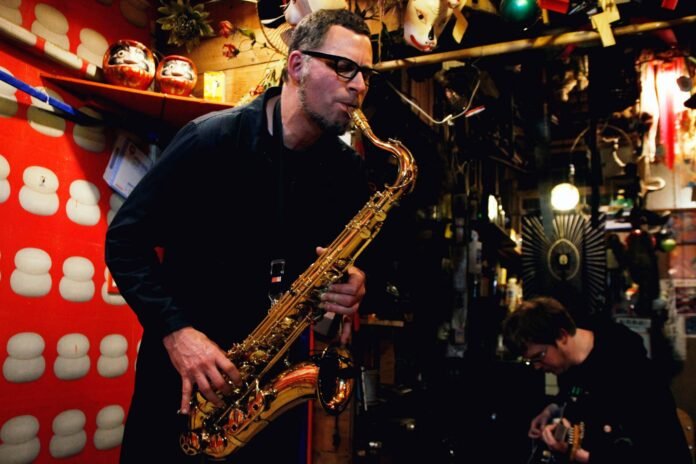
Table of Contents
Introduction
Jerry Gordon is a poet and musician from Los Angeles who has lived in Osaka for close to 30 years. Over the past three decades he has performed gigs with an array of talented musicians and dancers at venues throughout Kansai. Gordon’s debut novel, Terminalian Drift was published in the UK by Triarchy Press in 2021. Gordon resides in a studio and performance space in Konohana Ward called MIIT House. Scroll down to see his five favorite hangout spots in Osaka.
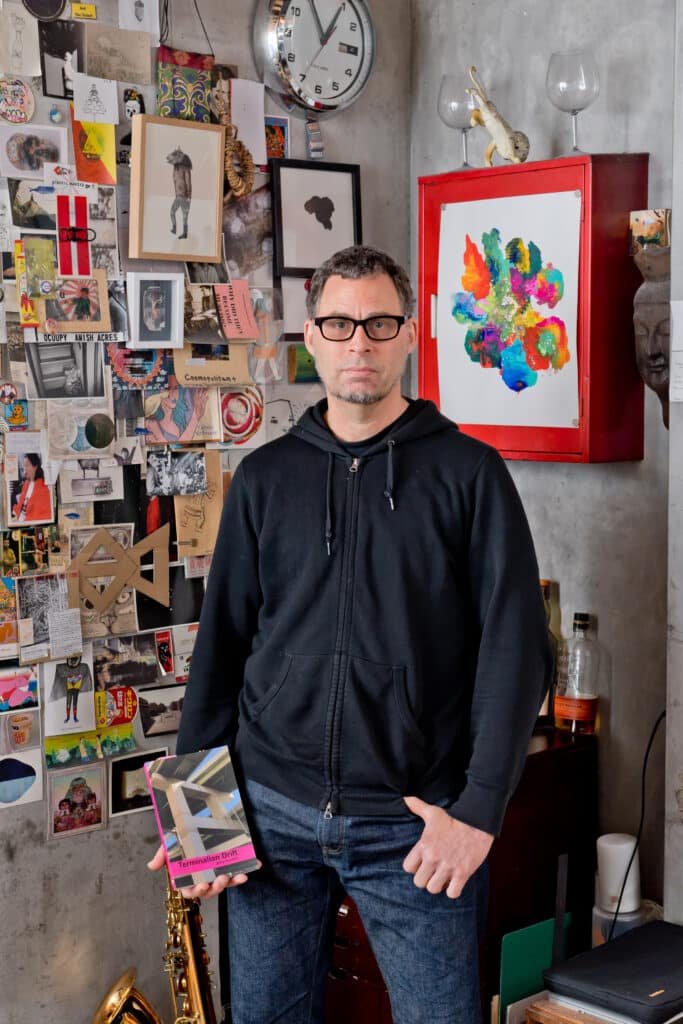
Book Review
Title: Terminalian Drift
Author: Jerry Gordon
Publisher: Triarchy Press
Published: 1st October 2021
Format: Paperback Pages: 192pp. Size: 21.6 x 14 cm
List Price: £12.50
In 1977 English writer Alan Booth completed a 2,000 mile journey on foot from the northernmost point of Hokkaido to Sata on the southernmost point of Kyushu that lasted 128 days. Booth wrote about his travels in The Road To Sata, which was published in 1985 and is now considered a classic in travel writing about Japan.
On February 23, 2018, Jerry Gordon, a poet and musician from Los Angeles who has lived in Osaka for 26 years, completed a 4 or 5 kilometer walk that started out on the corner of Midosuji and Doshomachi and lasted four hours and became the basis for his debut novel, Terminalian Drift, which was published in 2021.
Gordon wanted to try a different approach to writing a novel. He rigged a portable tape recorder to a striped walking stick in order to record the sounds and textures on his walk. “I took the walk with the goal to playfully document the sounds of the city’s bumpy and crunchy and spongy and slick surfaces,” writes Gordon in the books afterword.
Upon completing his journey, Gordon retreated into a local bar to listen to the recording. He took notes in order to remember the sounds and their locations, and over time these notes were augmented by Gordon’s fertile imagination into a multilayered novel that works on many levels.
The unnamed narrator of Terminalian Drift is a foreign man living in Osaka who purchases the skin of man named Andre Cadere from Amazon. After he tries on the skin it starts irritating him, so he he ventures the day of a festival known as Terminalia—the day when Osaka’s pharmaceutical manufacturers hand out excess stock for free to the city’s population. That’s really all you need to know about the plot, the best way to enjoy the novel is to jump in cold with as little information as possible.
I like to describe Terminalian Drift as an existential detective story with elements of science fiction and travel writing. The novel is a love letter to Osaka. Gordon has a gift for appreciating the beauty of the city in the spaces between densely clustered office buildings, through back alleys, under bridges, in hidden hallows, in recessed meter box lids, metal manhole covers, iron gutter gates and abandoned mail boxes stuffed to the brim with old fliers and adverts.
Gordon also serves up astute and wry observations about what it’s like to live in Japan as a foreigner without regurgitating the usual cliches found in scores of other novels set in Japan. Terminalian Drift is a novel that will appeal to fans of authors such as Nicholson Baker, Richard Brautigan, and William Least-Heat Moon. Buy the audio version of the book here.
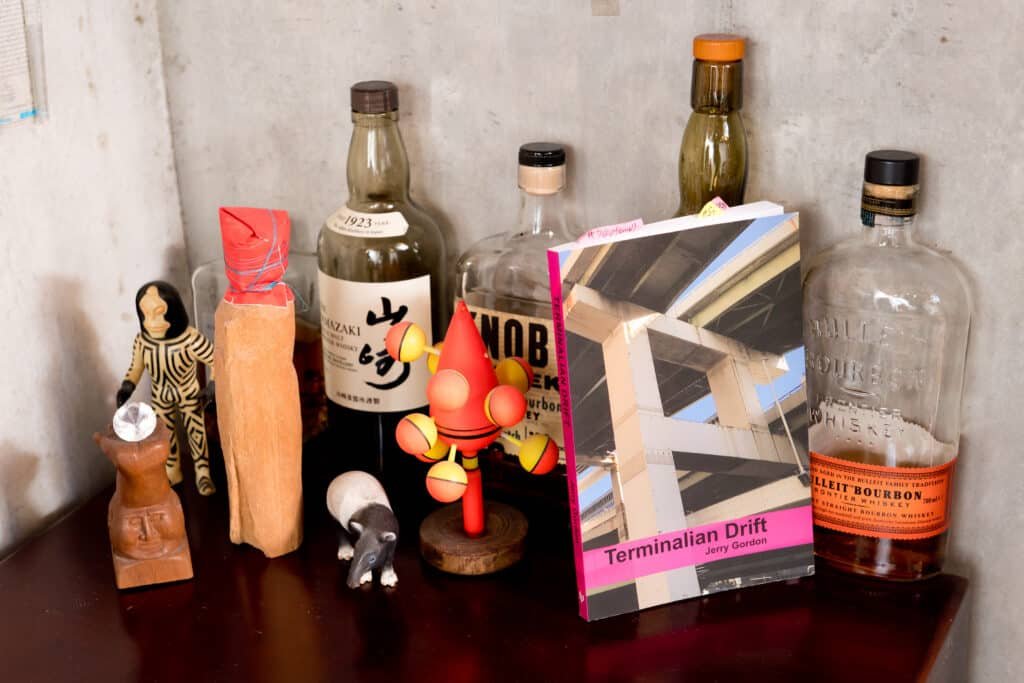
Interview
Poetry in Motion: Los Angeles to Osaka
Where did you grow up? Describe your hometown.
Jerry Gordon: I was born in Los Angeles and grew up in a suburb of LA. Glendora was a small city at the foot of the San Gabriel mountains, where all the smog from 1970s LA freeways got pushed by the ocean breeze. Commonly, the smog was so thick that we couldn’t see the mountains that were less than a kilometer away. I still remember the usual feeling of tightness in my chest if trying to breathe deeply in the summer months. Glendora was known for oranges and there were still some orange groves remaining in my childhood, which groups of boys would run through and play war in. It was a nice place, but not a place I’d ever like to live again.
What brought you to Japan (specifically Osaka)?
JG:I got married in LA to a woman from Osaka. I came here in 1994 to experience her culture. The original plan was to stay for five years. But, I fell in love with Osaka. It’s a great city It’s the greatest city I’ve ever spent much time in. My marriage to that woman didn’t last as long as my love for Osaka.
What do you like best about Osaka?
JG:There are so many things. I have come to love living as a foreigner in Osaka. Maybe my favorite thing about Osaka is that it is so geographically small. I can ride my bicycle all over the city. Coming from Los Angeles, where a car is so necessary for everything, living in a very walkable and bikeable place that is also so complex is great. I love meeting people I know by chance on the streets of Osaka. More than anything else, I would identify myself as an Osakan.
What are some of your other favorite places in Japan?
JG:Honestly, I don’t know much about other places in Japan. I’ve been to Kyoto, Nara, Kobe and Tokyo, but none of them compare to Osaka. I’m kind of that type of person. I’m not a traveller. I’m more of a stay in one place person. I like the rich depth of experiencing the same place again and again.
When did you develop an interest in poetry and who are some of your favorite poets?
JG:I remember the first poem I wrote was in kindergarten. It was something about three wishes which included a purple hippo. It was published in a mimeographed booklet along with everybody else’s poems. I can still see those purple typed words on a page in my brain. And, I have continued to appreciate that style of letting everybody mumble next to everybody else. No editorial pick-and-choose of only letting the “Best” be included. I like poems that kind of find me without me looking for them. Poems that are sent by friends, etc. My favorite poets are Dan Marlin, Billy Collins, Rumi and many more.
How many books of poetry have you published?
JG: I’ve put out four selections of my poetry. Three books: Language Unfitting (1996), YOU (2007) & Ghosts (2017) and one CD: Fully Formed Failure (2003). I put out a book of my poems paired with drawings by Gareth Morris Jones, called Milagro (2007).
I also published a CD called Kansai Poets: Volume 1 (2004) featuring six expat writers active in the Kansai area (Jonathan Crewe, Robin Gunkle, Dan Marlin, Andy Moat, Michael Salovaara and Gerald Staggers.)
All of these were published out of my little factory of production: 3CMPress (Three Cornered Moon Press). 3CMPress is now mostly active for releasing music (via Bandcamp) https://moontriangle.bandcamp.com/music
I’ve had poetry published in various little other journals, such as the Tokyo Poetry Journal (which Taylor Mignon facilitates pretty regularly).
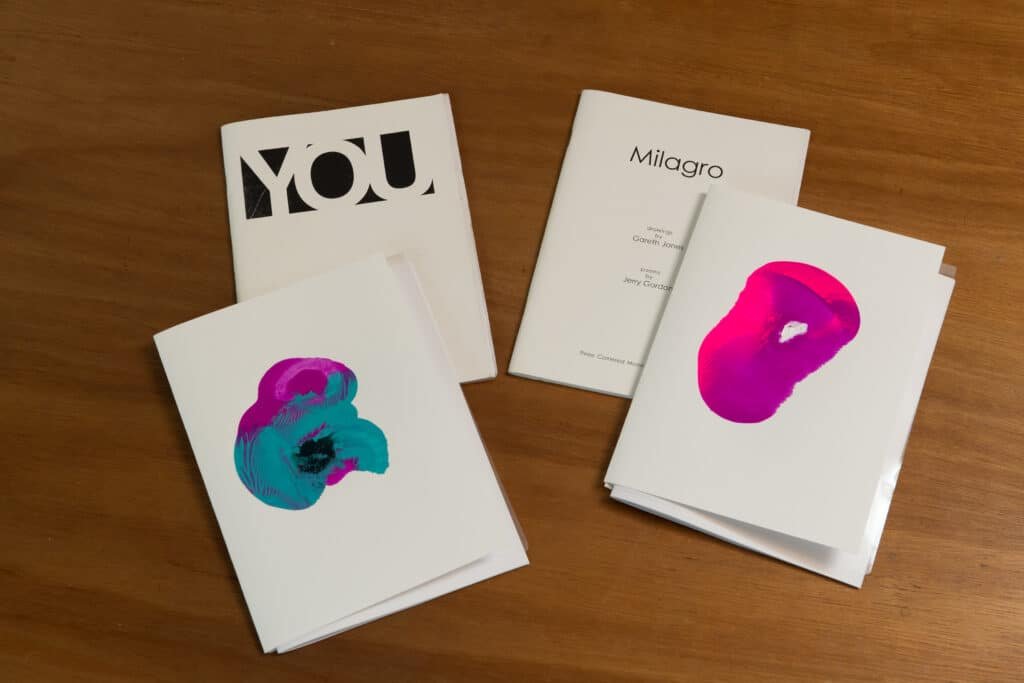
What is your favorite poem you have written?
THUS THIS
On this train
with this man holding his case
and this roar rumble
through this dark tunnel
and the universe
All
coming together thus,
I lean out
and kiss your head
to participate in the perfection
like this.
Two lines from this poem are now tattooed on my daughter’s arm. When she was thinking to have the phrase “May the force be with you” tattooed on her arm, the tattoo artist advised her to think more about it. She did, and then asked me to give her a line from my poetry. This poem was written for her when she was around 5-years-old, so it was easy to know what poem to select from.
Osaka Drifter: Confessions of a Novelist
Had you written prose or short stories before writing Terminalian Drift?
JG: Terminalian Drift is the longest piece of prose I’ve completed. There have been several other novels and films that remain in different stages of not finished. But, I’ve written a fair amount of short fiction and academic prose. And I like the form. My fiction work usually has a first-person narrator who reveals stuff about himself (I don’t think I’ve ever had a female narrator). I’m very influenced by Jorge Luis Borges and Don DeLillo, but there are so many great prose writers. I used to like Murakami and Vonnegut a lot, but I haven’t read them for a while.
What do you feel was the biggest challenge in writing a novel?
JG: Not stopping. I had a deadline to finish the story in a year, and miraculously I didn’t flake out on it. I have so many wonderful stories that have become lost in the flutter of their notes and various potential trajectories. Terminalian Drift proved to me that I can finish something long, but I know the value of a deadline for building the pressure to actually realize a story’s completion. I hope I can keep a focus like this again.
Explain drift, psychogeography and mythogeography for people who are not familiar with these terms.
JG: These are all terms related to walking arts, which is kind of a mode of hacking mundane life to make it more than merely livable. As Robert Filliou said, “Art is that which makes life more interesting than art.” And, I think that is true about walking arts in how they experiment with life to make it beyond the limitations I (we) impose on it.
Drift is a mode of moving through a city (or any place) without a predictable purpose or goal. Drift is a name for various methods for getting lost. It is a way to suspend the assumed stability that breeds the boredom amidst this death-defying act of living. Drift pops the walker out of a rut of living trapped by routine, making ones surroundings unfamiliar or even disorienting.
Psychogeography is a way of examining and playing with experiences in the world. Psychogeography examines how the experience of place affects the person within it, and vice versa—how the person affects the place, how place is made by the walker and the walker is made by the place. Psychogeographic activities offer methods for altering the relationship between place and the individual experiencing it.
Mythogeography, as I understand it and am interested in using it, focuses on a third aspect that connects or facilitates the person/place relationship. That third aspect is the narrative link that forms between person and place. Often times, the story about a place is one of authorized history, for example a plaque or monument is erected to convey the official narrative of a happening in a place. This is what tourism is often about.
Mythogeography, however, encourages an active creation of personal stories within or in relation to places. It encourages a layering of stories amidst or upon a place. This narrative layering serves to weave the personal into the poetic, making the mundane mythic. Voices mutter amidst voices, perhaps obscuring or undermining the authoritative power of the official history—which is widely known to be what only the “winners” get permitted to write.
So, for me, walking arts (and what I experimented with doing in Terminalian Drift) enable me to influence the creation of this city I love but am only a blip within. While I am here, I can make this city include my blip, reflect my blip–at least for myself. We each are a small blip, but each blip gets to sound and echo, each gets to flash and glow for its own brutal and beautiful brevity.
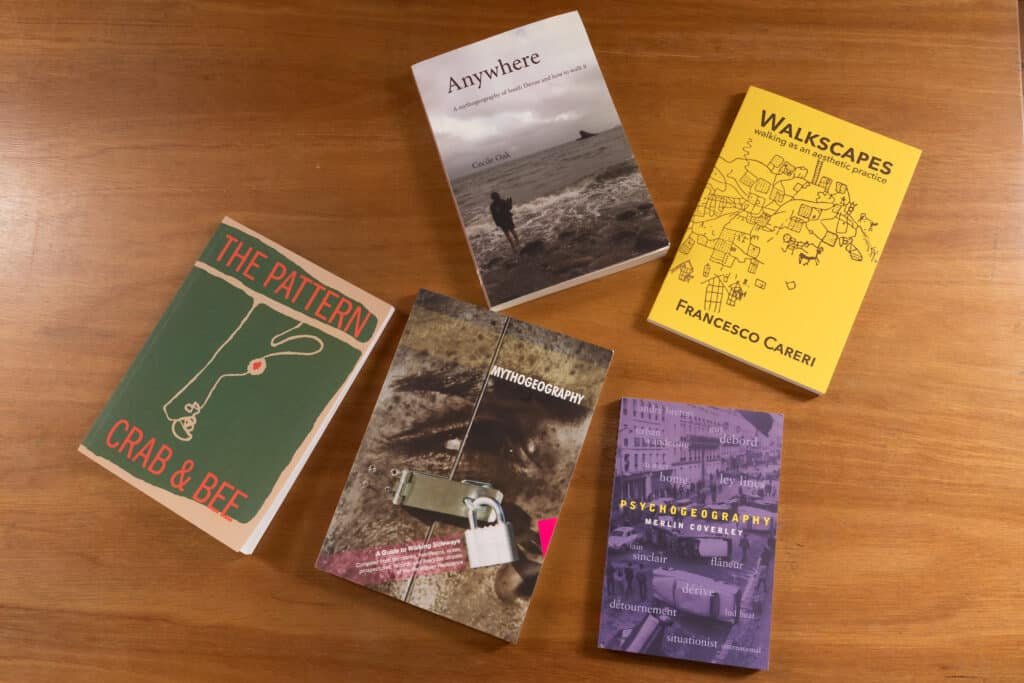
Do you consider Terminalian Drift to be a science fiction novel? Do you have any favorite science fiction novels or movies?
JG: What I like about science fiction is how it tries to accurately imagine the ramifications of slight (or major) differences in the actual world. I like how science fiction explores the ripples that roll out from those differences that it imagines and how those ripples alter norms and modes of being. In those ways I can think that Terminalian Drift is science fiction, but I think it could also just be called experimentation, or just The Novel. I’m more influenced by the magical realism of Gabriel Garcia Marquez and Borges than by a lot of science fiction, but I like William Gibson and Phillip K. Dick.
Terminalian Drift combines facts and alternative facts about Osaka and it is often impossible to ascertain fact from fiction. Did you have a technique such as studying guide books or history books?
JG: I researched Osaka via various sources, from maps and history museums and various texts and images, but also just imagining the logical steps that brought moments in the past into what Osaka is today. As the story points out, there are hints everywhere showing ways this city gets made from a million little alterations always taking place.
Some changes come from above (like the rebuilding of a bridge or a subway stop), while other changes come from below (such as stickers on a lamp post or a worn section from people taking a shortcut across a patch of grass). Both have reasons, goals and logics for what they do.
My interest is to be attentive to the “from below” a bit more than the “from above.” It is also my interest is to slightly erode our confidence in the official stories told by from above for why they do what they do. Both the city planner and the graffiti tagger are working to shape the city with their desires. I’m interested in both, but a bit more fascinated with the desires of the latter.
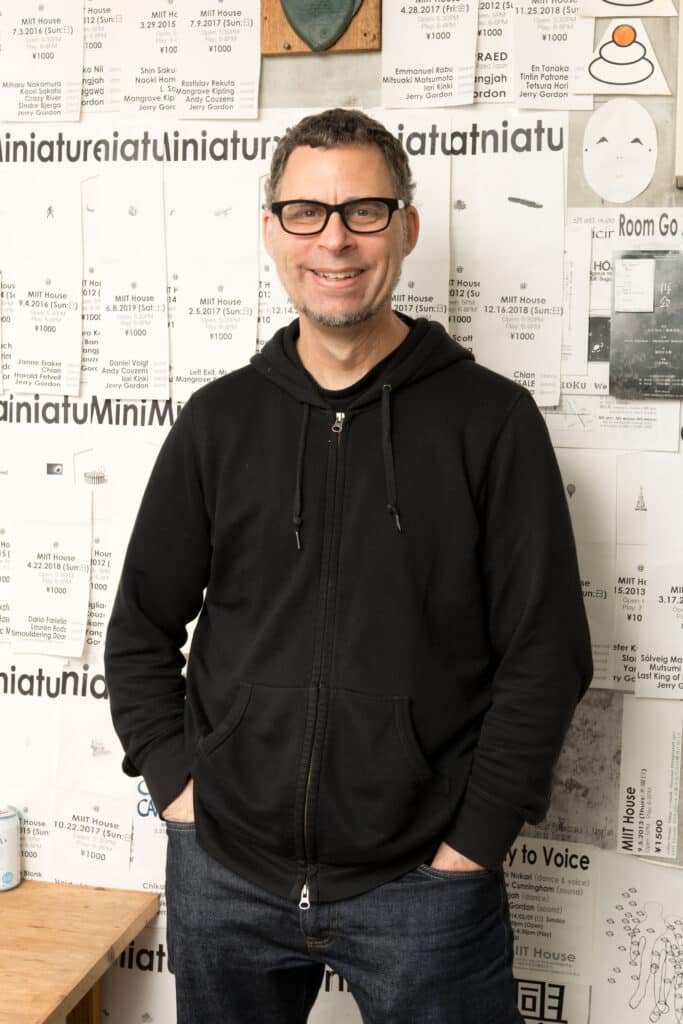
Terminalian Drift: Coda
Note: The following was excerpted from an email exchange with Jerry Gordon after the interview was conducted.
Osaka.com: I thought the book worked on many levels and I felt it was one of the most accurate descriptions of living in Japan as a foreigner. In my interpretation the skin was how we experience Japan vicariously via our smart phones and social media. A lot of what we learn is second or third hand information, not actual experiences. It’s like how when we visit a temple in Kyoto we accept the information as fact, but if we read a made-up history of the temple we would also accept that information as fact and repeat it to others. I was walking through an old shotengai in Taisho the other day and had I strong sense of deja vu. Then I realized I HAD walked these same streets via Google Street View and my brain registered that experience as an actual memory. That’s why I love the line from your book: “In a used skin there are often bouts of memory seep.”
JG: Cool. I agree with all that. I definitely think the acquired skin works as a metaphor for exploring how “authentic” my experience is, both as a foreigner in Japan, but also as a traveler through life/time. The world that informed/made me as a child is so different from the world of now. It sometimes makes me wonder how many selves I have occupied in my life. Are selves skins that I have inherited, discarded and taken possession of?
What happened to that boy of 18 or 28 or 38? It sometimes feels as though I am stepping out of and into different worlds of time. But, of course, living as a foreigner has made that even more intense. I both share and don’t share so much with the people so closely around me. That is a kind of deja vu for me, like I am experiencing things in life (generation gaps and culture gaps and life gaps) that appear from living long enough and paying attention.
The generalized experiences that I’d heard about from others growing up–the deaths of loved ones, and feelings of being lost, and values of intimacy, and moments of raw kindness—appear in my experience as specific and embodied reality. The Google View of life that I’ve learned from becomes real and specific and semi-miraculous.
About history, I am very interested in the difference between experienced moments in places and those kinds of authorized (and unauthorized) histories that you mention regarding Kyoto temples. My focus is more on exploring the fact that the city (of Osaka) or any place is layered with intensely personal histories and stories, and that these have been accumulating in specific places (at corners and on bridges and along rivers, etc.) for thousands of years.
Some of these histories get officially highlighted and used to try and fix a place with a meaning. A plaque gets erected. But, my interest is more in how places are always equally open to the beautiful mundanity of the invisible first-person experience. Of my specific experience marking the place with invisible ink. I am interested in imagining those uncountable unnoticed layers that we each scratch into a place by living in it.
Meditations on Music Mantra and Ghosts
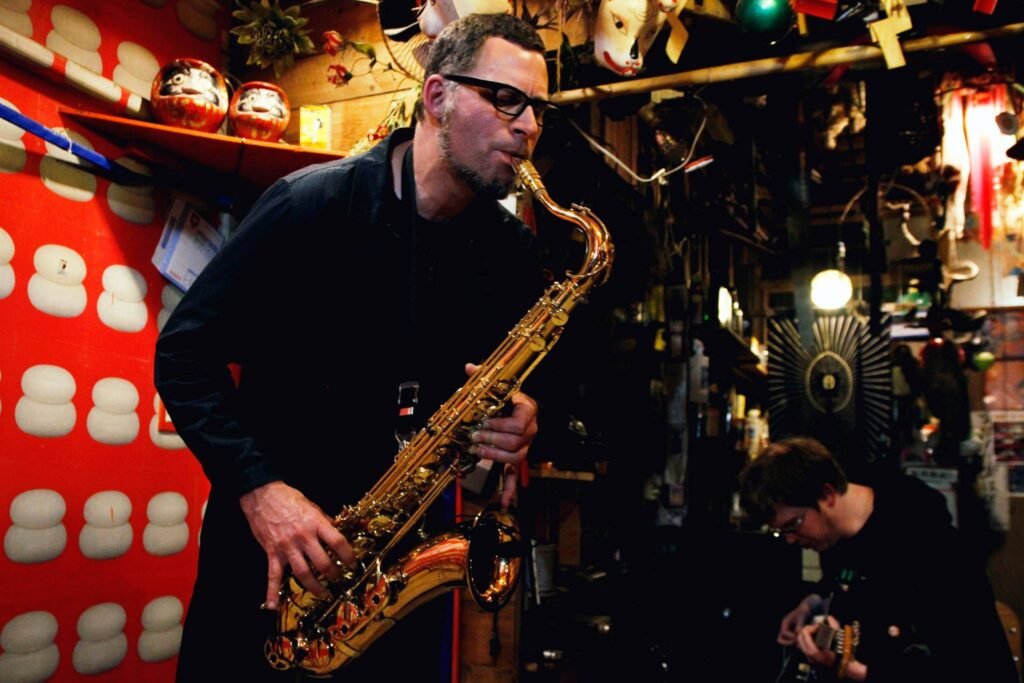
What’s your background in music? Were you in any bands before coming to Japan
JG: I am completely raised-by-wolves when it comes to music. I never had any music education when I was a child, so I feel my approach to music now is largely born from that lack of authority and training. I view that lack of a traditional musical view as a very positive thing. But, I think poetry has guided my making of music, at least it did in the beginning. I was writing and performing poetry for a long time before I started playing music, so I could feel that the music followed my sense of how poetry works and how poetry uses time. For me, my music is similar to how my poetry turns upon itself and abruptly shifts and collapses expectations of what the next moment will bring.
Was it difficult to get gigs in Japan when you first arrived?
JG:I started playing music around 2001. At that time, I mainly only found chances to play at friends’ art show openings. But gradually I found more venues that were hosting my kind of music.
As with much in Osaka, getting gigs was about finding access to the right portal into the underground that I needed. Osaka is a city of millions and there are so many layers of scenes. Once I could find access into the improvisers’ world, I was welcomed and chances to play and collaborate with musicians, dancers and artists started appearing. Osaka is known for being friendly and less formal. And that has been very true with the improvisers’ and experimental artists’ scene in Osaka—but also with those scenes in Kyoto, as well as in Korea and China. This is maybe true with any scene. Once you find a way in, you are connected to everyone around the world. There is a shared understanding and a quickness to trust other members.
What do you like most about performing in Japan?
JG: The organizers and venues and audiences in the scene I play in are mostly genuinely friendly and creative people. There is almost no money moving in the scene or from the events, so it is really about the creative desires and openness of people involved. Ironically, because there is almost no money to fight over, people are quite generous and fair. They aren’t measuring their value by money, so it is more about the genuine sense of personal, artistic and playful expression.
How many bands are you currently active in?
JG: Right now, I’m in two, both duos with Charles-Eric Billard: Smouldering Door and Plastic Mantra, which is best described as authentic fake Indian music. Our latest project is a film I made called Smoke Ghosts. It is a music video for several PLASTIC MANTRA songs that appeared on a CD that Charles released around that time. So, in short, it’s a music video / experiment in film making. I have another film currently in process. It will use one of the characters in Smoke Ghosts, but it will be less PLASTIC MANTRA music focused and more experimental film focused. If I ever get it done.
But I also do a lot of collaborations with musicians, such as Kayu Nakada, Tetsuro Hori, Gregory Hilton. And, a lot of dancers. I’ve been in about 20 groups over the last 15 years. A third band called Zujaka might still be alive, just in hibernation.
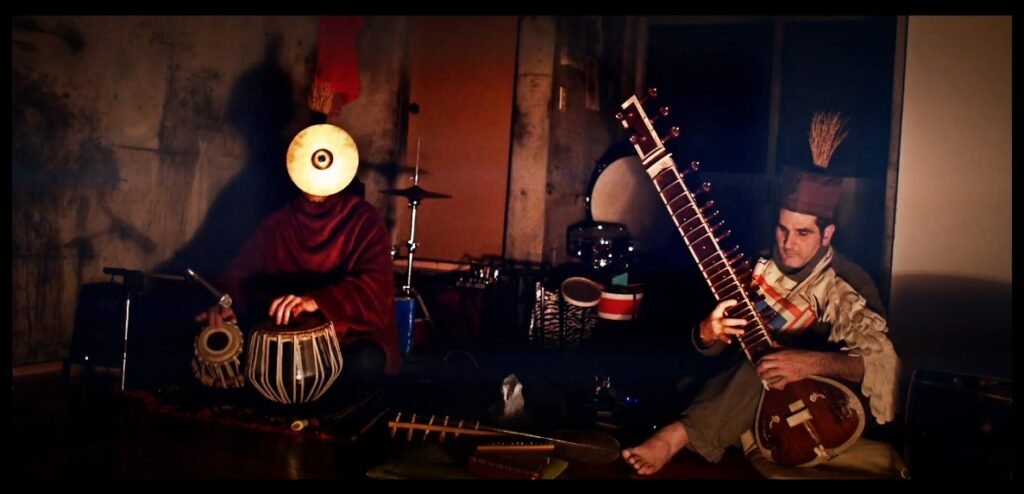
Who are some of your musical influences?
JG: Charles-Eric Billard, Takeshi Hasegawa, Miles Davis, Ornette Coleman, Tim Olive, John Zorn
I could easily live without hearing recorded music. It would be harder for me to live without playing music. That said, my current Fav-Five are Sam Gendal’s “Satin Doll“, Ben Lamar Gay’s “Downtown Castles Can Never Block the Sun“, Archie Shepp/Max Roach’s “Force: Sweet Mao,” Santa Sprees’ “Fanfare For Tonsils“, and the album I’m recording right now in collaboration with German photographer Katja Stuke, called “Trees in Ukraine” based on photos she has “taken” of trees in various Ukrainian cities via Google Street View.
Dance, Dance, Dance, Dance
Do you feel connected to any particular music or art scenes in Japan?
JG: Very much so. The improvised music and dance scenes, also experimental music and performance, Butoh dance scenes.
You often perform with dancers. Have you always had an interest in dance? Talk about some of the dancers you have worked with over the years.
JG: I love playing with improvising dancers, usually Butoh dancers. A lot of what I know about improvisation comes from playing with dancers, in particular the dancers Yangjah, Yasuo Fukurozaka, Chikako Bando and Nonoko Sato.
Like improvised music, improvised dance is an extremely ephemeral art. They both focus wholly on flowing with and responding to the shifts in the present moment. Once the performance is ended, everything vanishes. Merely intensities of memory remain. Dance is a visually oriented practice in space and time. Dancers are amazing for how they commit their bodies into the space, allowing the eyes of the audience to respond. It’s such a physically intense art. Their bodies become the vehicles for the viewers’ imagining and desires and voyeurisms and movement through time. Dancers have special powers, like ritual enactors.
What is the best show you have ever played?
JG: It’s hard to choose, but playing Zujaka with the dancer Yangjah at Night of 1000 Eyes at Pika Space in Shin Sekai was a great one. The energy was amazing and it became released as “Jet Back” by Dagoretti Records
“The show was nothing short of spectacular, the kind of experience that you imagine audiences of great jazz and experimental shows of old had, the kind where, after it is over, you suddenly realize that you were privy to something special. So, you thank yourself for taking the time to go out and see some live music and understand exactly why you should do it more often.”
Dr Peter Larson, Dagoretti Records
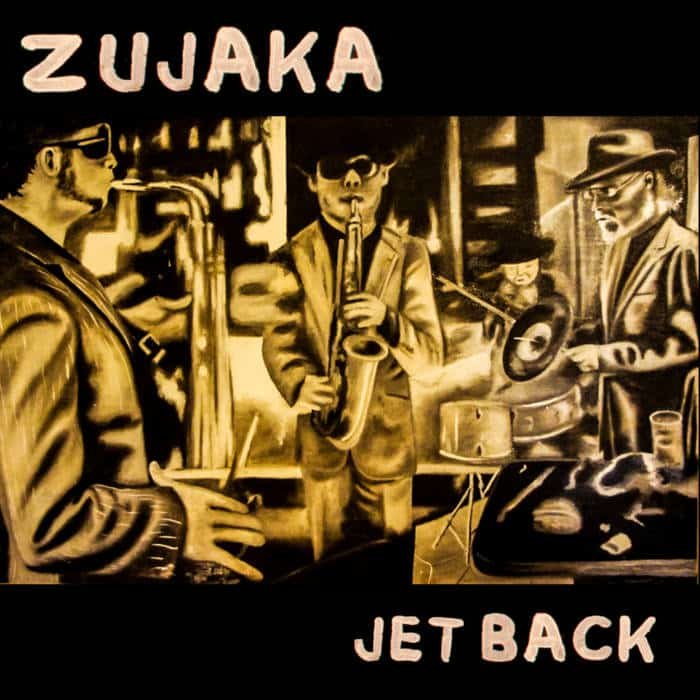
What was the strangest show you’ve ever played?
JG: The strangest show I’ve ever played (and there have been many) was playing solo inside of a 100 plus-year-old water well in Kobe. I played standing on a rope ladder about 15 meters down inside the earth. The well was supposed to be dry on the bottom, but the well had other plans and there was about a meter of water under my feet.
Jerry Gordon’s Osaka: Five Favorite Hangouts
1. MIIT HOUSE
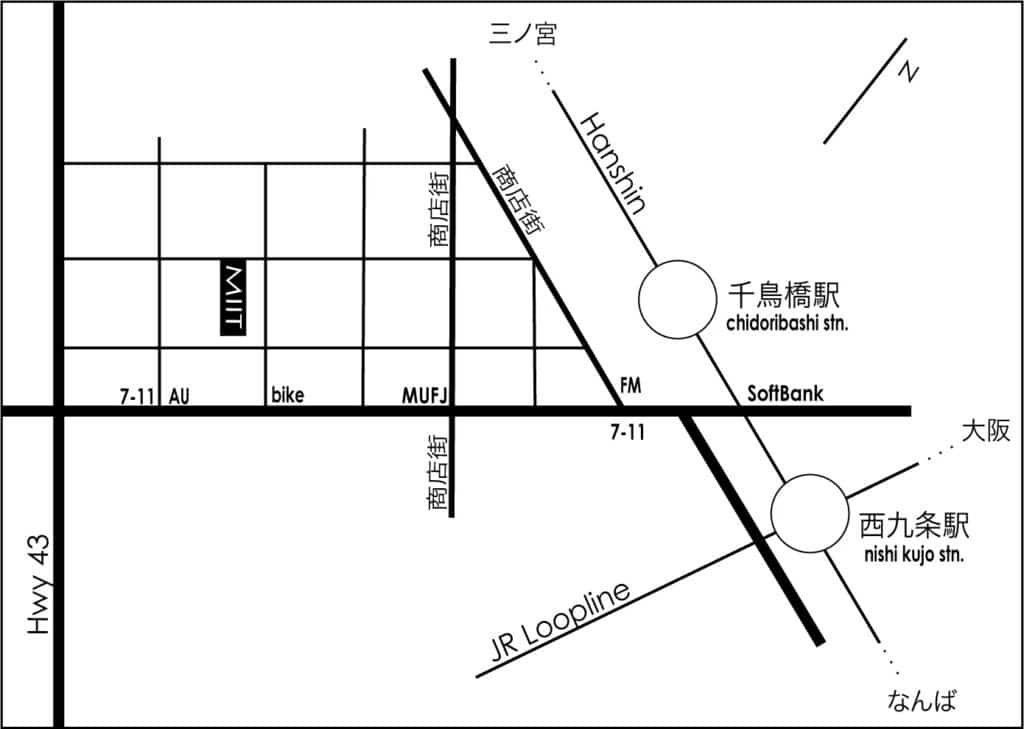
Address: 6-13 Shinkanjima 2-chome, Konohana Ward, Osaka, 554-0014. Open: Check website.
We don’t have to travel far to the first location on Jerry’s list. We have been here for a couple of hours shooting photos and rummaging through Gordon’s collection of albums and books. I even took a peek in his trash can on the sly. “MIIT House is my living/studio space in Konohana Ward,” says Gordon. “It was formerly a meat factory, preparing food for the local shotengai.
Gordon has been hosting an event called Miniatures since 2012 that has brought together scores of talented artists, poets, writers, musicians and dancers from throughout Japan and all over the world. MIIT House is one of the most intimate venues to live performance in Osaka. As soon as you take off your shoes and step inside, you know you are in for a special evening. Make yourself at home and buy a beer from the refrigerator in the kitchen. Before the pandemic hit, Gordon had hosted 84 performances in his residence under the Miniatures banner. The last one was held in February of 2020, but keep your eye open for upcoming events. The entry fee is only ¥1,000.
MIIT House is part of the tight artist community that resides in old buildings, former shops and warehouses in the areas of Baika and Shinkanjima near Chidoribashi Station. Don’t expect to find a whole lot of information about local events online, a lot of the promotion is still done with handmade fliers and good old-fashioned word of mouth. Attending a gig in this fascinating area will open your eyes to an underground scene that has attracted a devoted following of like minded travelers. MIIT House (English spoken here!) is a great place to start.
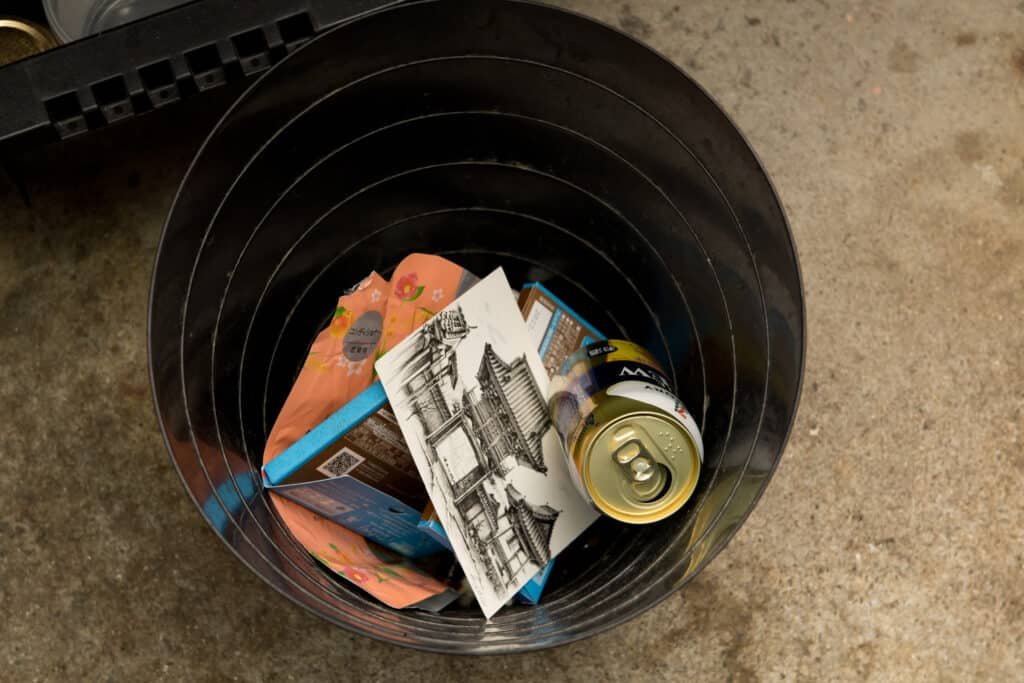
2. Rodda Group Curry
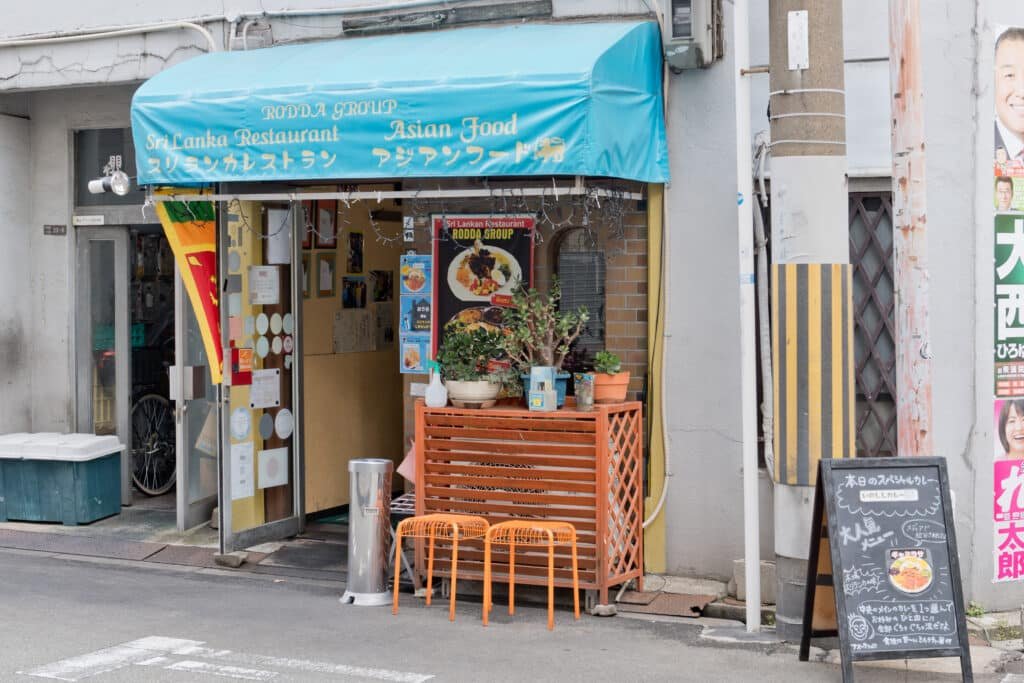
Address: Sakura Building No 2, 1F, 1-chome 23-9 Chiyozaki Nishi-Ku, Osaka, 550-0023. Tel:06-6582-7556. Open: 11:00-15:00, 17:30-21:30. Closed Thurs. Website
Our next stop is Rodda Group Curry in Kujo. “Rodda Group Curry Shop in Kujo was surely long ago a tiny snack bar,” says Gordon. “For over ten years they have been serving excellent Sri Lankan curry dishes, but the furniture seems to be unchanged from its snack bar years.” I don’t think I’ve ever had Sri Lankan curry before. I know that it tends to be spicier than Indian curry, and was instrumental in influencing the current spice curry boom in Osaka.
Rodda Group specializes in Gami Rasa curry, which means “taste of the village” in the Sinhala language. It’s curry over rice with colorful side dishes. You can choose from 10 different types of curry including pork, fish, chicken, mutton, goat, wild boar, deer, nankotsu (chicken cartilage) and zuri (chicken gizzard). The curries run from ¥1,500 to ¥1,800. The special of the day is wild boar, so I order it.
Our food arrives. My dish looks like a work of art. It contains cranberries, a red yellow and green peppers, a hardboiled egg and poppadom (flatbread). It just so happens that I saw a report about Rodda Group on television a few months ago. In the episode the young talent or influencer refused to mix the curry (maybe she wanted a nice photo for Instagram?). The owner came over several times and said “yoku mazete kudasai” (please mix it well) but she refused his request. Finally the exasperated owner took a spoon and mixed it himself. I wasn’t going to make the same cultural faux pas, so I mixed that curry as soon as the owner set it down. After we got a nice photo, naturally.
It’s a good thing Jerry and I ordered two large bottles of beer in advance because this curry was spicy hot—and I mean that in the best possible way. I must have downed three glasses of water in addition to the beer. The taste was much different than what I usually have in Japan. I wasn’t about to ask the owner for the secret recipe, but I believe the cardamom and fenugreek run strong in this curry. I really enjoyed this curry once I got over the initial shock to the system from the wonderful combination of spices and intense heat.
We found out later that Rodda Group is popular destination for curry aficionados in Japan because of its unique taste. It is also very popular with locals. Make sure you arrive early in order to get seat at the counter.

3. Columbo Corner Shop Bookstore
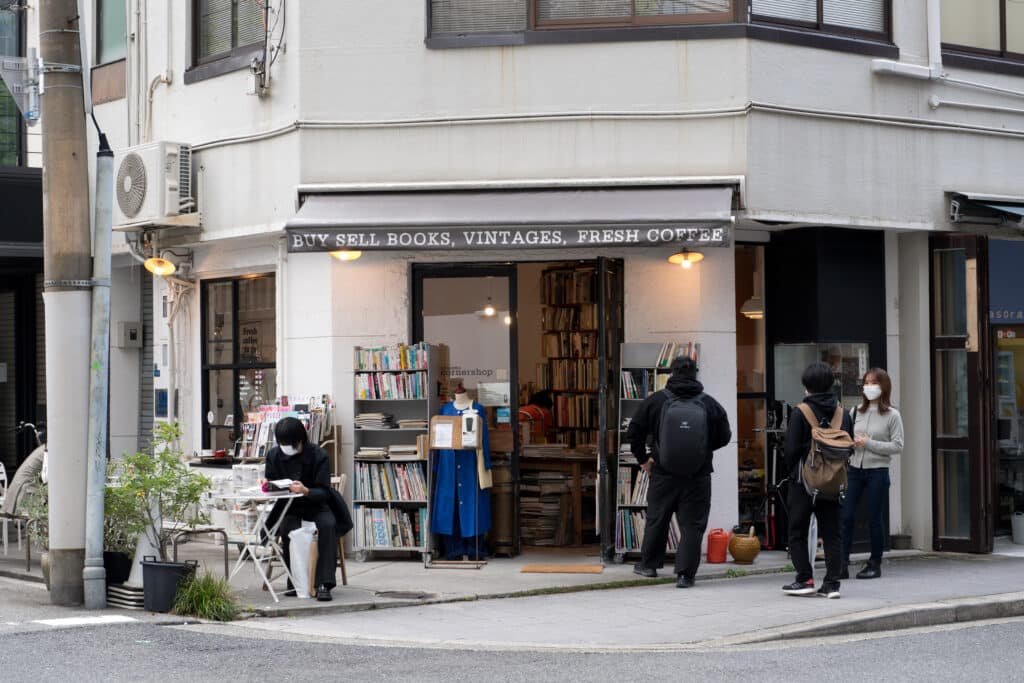
Address: 3-9 Minamikyuhojimachi 4-chome, Chuo Ward, Osaka 541-0058. Tel:06-6241-0903. Open:12:00-19:00. Closed: Wed. Website. Facebook. Instagram.
Stuffed to the gills we are in need of some caffeine. Gordon takes me to the Colombo Corner Shop Bookstore and Coffee Shop in Shinmachi, which he promises has the “best out-the-window cappuccino in the world.” It seems a bit out of place in this swanky part of town near a Ferrari dealership. Gordon was not exaggerating about the thick and creamy cappuccino It might be the best cup of coffee I’ve ever had in Osaka, and a steal at only ¥300.
We notice a couple of young women posing in front of a rack of foreign fashion magazines such as Vogue. This corner of Osaka has a very European feel, and I could sit outside and watch people pass by all day. While we were enjoying our coffee, local artists Kim Dunstan and Gregory Hilton stopped by for a friendly chat.
The inside is crammed with stacks of art books, photo books and other interesting publications from around the world, including vintage rarities and collectors items. I browse through a selection of English novels by the window. I believe this is the shop that Nicholas Currie, aka British pop singer Momus, used to frequent when he lived in Osaka, but I could be wrong. The owner, Takahiro, has two beloved cats named Django and Marco and the shop sells an original t-shirt with the slogan “Cat Knows It’s True.”
“I’ve occasionally seen the owner boxing up a heavy bundle of books,” says Gordon. “He sells them by the kilo as props for photo shoots and fake interiors displays at furniture shops.” I often see old foreign books used as set decorations on Japanese talk shows and I’ve always wondered where those old books come from. I guess there is a niche market for everything. A nice report on Columbo Cornershop by an Australian blogger can be found here.
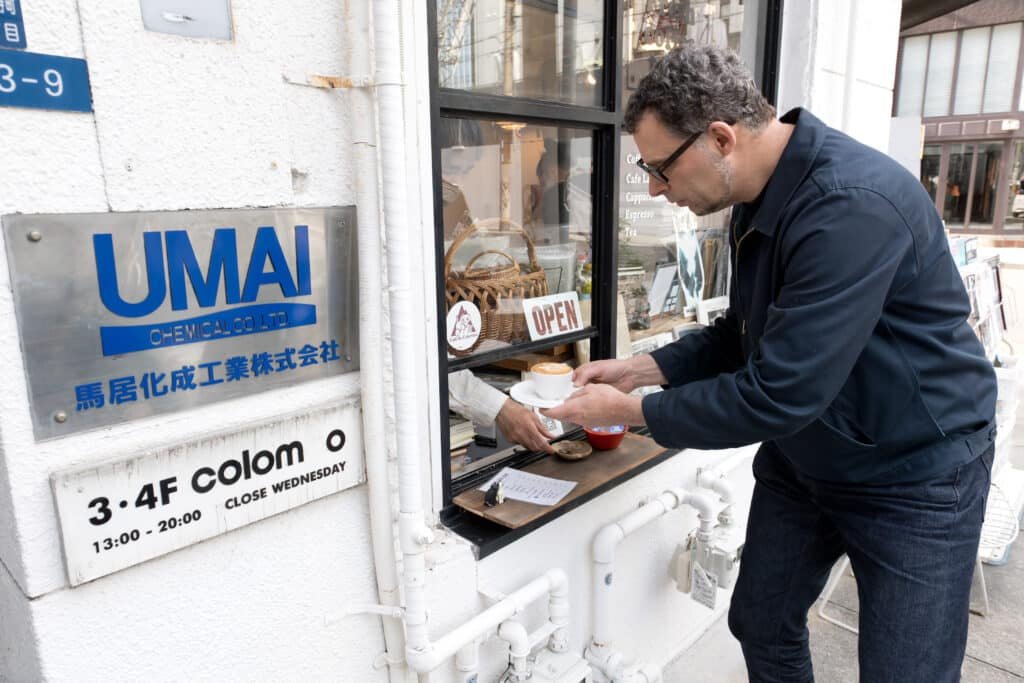
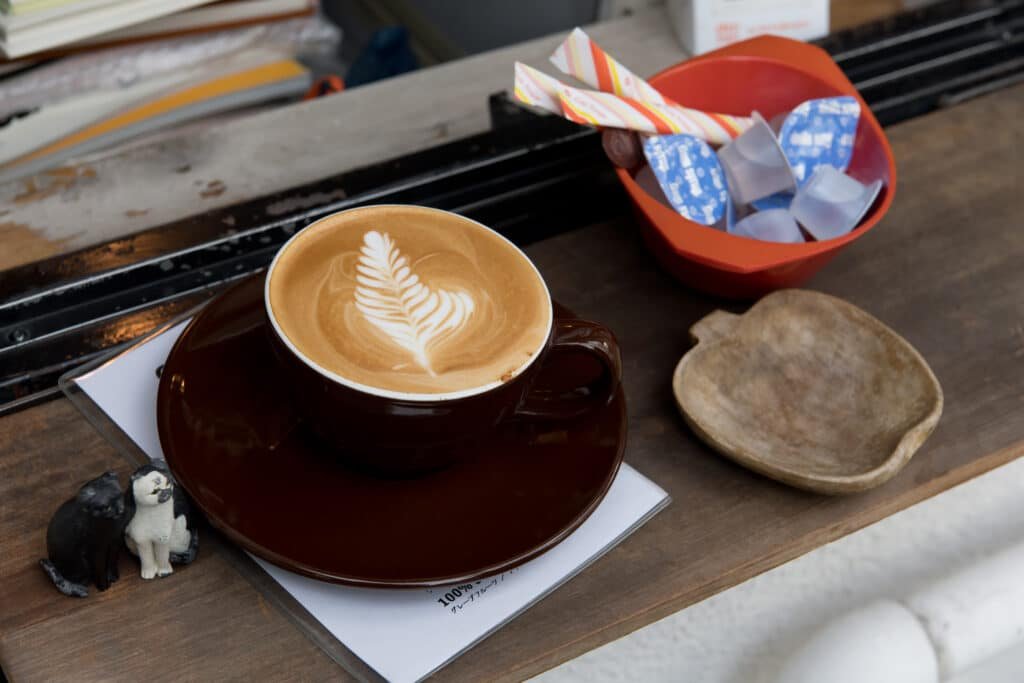
4. Concrete Canyon Midosuji

We come to narrow road off of Midosuji in Yodoyabashi between two tall office buildings that Gordon has named “Concrete Canyon. “I don’t remember when I found it,” says Gordon. “But I decided it would be where I would play every 12 years on the day of my arrival in Japan. I arrived in Osaka in the Year of the Dog, so I have played a solo event two times since I arrived. I also made an album of solo music and a short film with the dancer Yangjah here called Concrete Canyon. Sorry, I don’t know the GPS coordinates, but it is one block north of exit 12 from Yodoyabashi Subway station on Midosuji. It’s a great-sounding and squeezy vibe location in Yodoyabashi.”
Jacket: Perks-at-Work ¥43000. T-shirt: Unicloak ¥5200. Jeans: AiYaiYai ¥38000. Boots: Martini PhD ¥25000. ManPurse: Stax Girl (used)¥8000 Hair: 22mm ClipClip–(points card credit). Glasses: 4-Eyed-Monster ¥60000. Hoodie: Kujo Shotengai ¥200.
5. Sky Blue Pedestrian Bridge
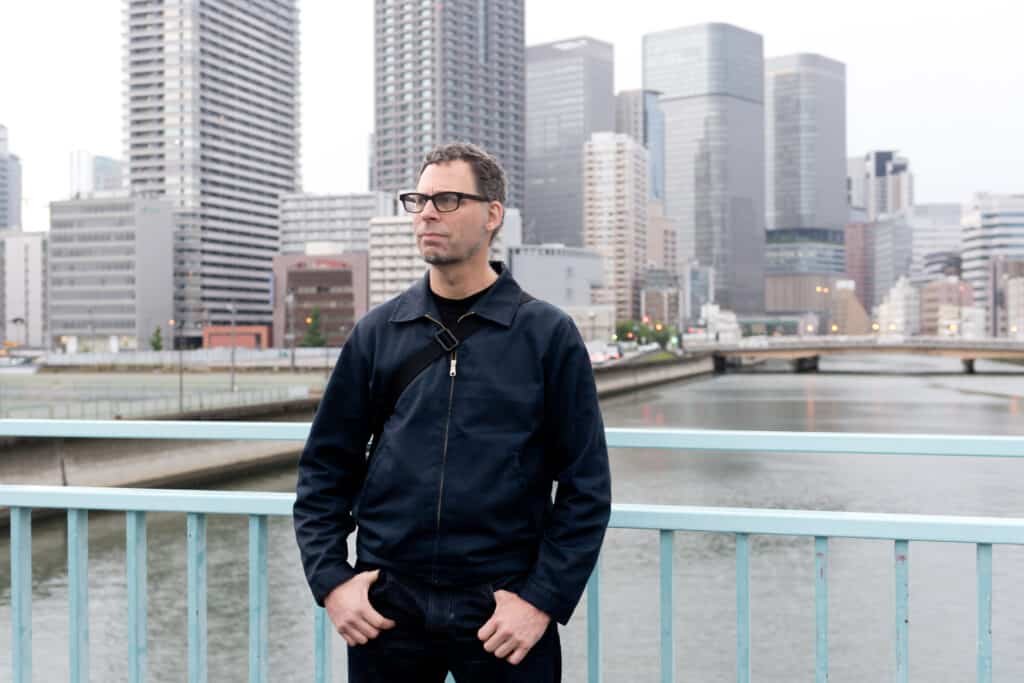
The final stop on our tour is what Gordon has named the Sky Blue Pedestrian Bridge. It is located directly south of the Rhiga Royal Hotel in Nakanoshima. The view is stunning and the area is quite peaceful. “I also don’t remember when I found it,” says Gordon. “But I remember the shock of seeing the wall of Osaka buildings. I’ve never done any performance on the bridge, but I did do a series of recordings with Charles-Eric Billard called Tunnels and Bridges on which we played various metal bridges in Osaka. Maybe I didn’t know about the Sky Blue Bridge at that time. I have had a couple picnics on the bridge as it is a nice, uncrowded place with a nice view.


























Very interesting read.
Jerry is super talented and sometimes stands sideways.
Really enjoyed this! Read it over twice in places! Great interview!,!. Love us some JG!
Wes Wesson